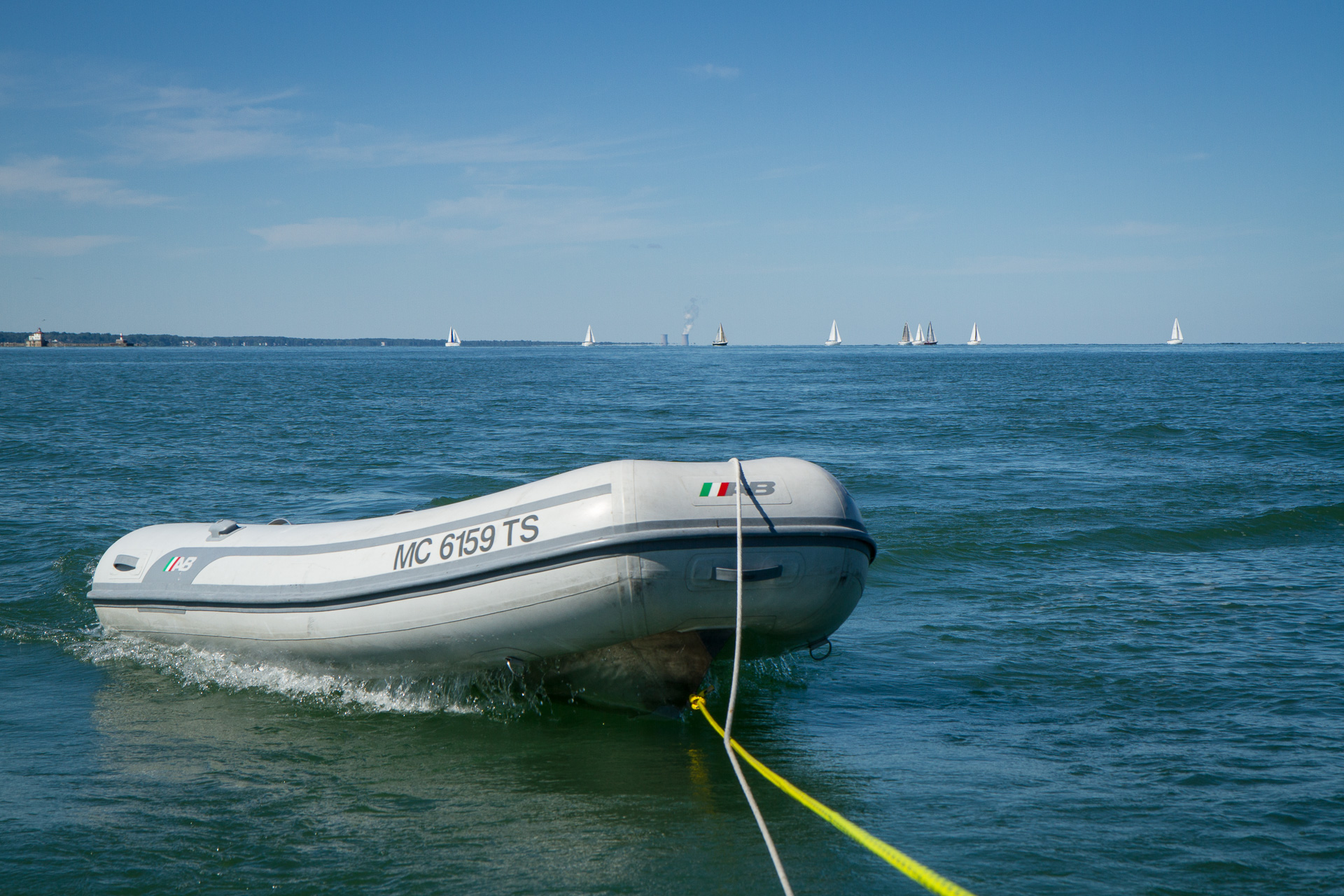Don’t worry Mom, no one really went overboard! We were on our way from Cleveland to Geneva motor sailing in about 15 knots of wind from behind with two to four foot waves left over from strong winds of the previous 24 hours. It was pretty rock and rolly, but not terribly uncomfortable. We’d just finished eating a small lunch, Jim was at the helm, and I had my laptop out and was working on a blog post, when I heard an expletive, and then, “We lost the dinghy!”.
Time for a man overboard drill! Jim pulled in the jib, grabbed the boat hook and went up on the bow, while I approached the dinghy heading straight into the wind so we wouldn’t sail past our wayward little boat. Of course, when you’re heading into that kind of wind with two to four footers, the bow of the boat is bouncing all over the place. Not ideal conditions for trying to catch a dinghy with a boat hook! He did latch onto one of its handles with the hook and carefully walked with it to the back of the boat, still not sure exactly how he was going to reattach the line from the boat to the dinghy. I grabbed the boat hook and held onto the dinghy for dear life, while Jim climbed from one big bucking boat into the other and somehow managed to reach under and reattach the carabiner without falling out of the darned thing! He also attached a second line for some peace of mind and carefully made his way back into the bigger boat. Mission accomplished…for now.
This is our second year owning this dinghy (an AB brand with an aluminum bottom) and we have yet to find a way to tow it behind us that we are totally happy with. Seems like no matter how we tow it, it simply will not follow along behind us in a straight line, but rather rides back and forth from side to side looking like one of those erratic drivers that’s trying to pass everyone he comes up behind! We’ve tried a few different ways of towing it, and this was our first time trying a floating dinghy tow line (polypropylene core with a polyester outer braid). The line was tied to a hefty carabiner using a bowline and the carabiner was hooked onto the dinghy’s metal attachment point. When we realized the dinghy had become detached from us (which Jim realized immediately because of the change in sound), we first thought the tow line had broken, but as we pulled the line in, we realized that it had not, but rather somehow the carabiner had opened itself and unhooked the line from the dinghy. Not good.
So….anyone have any experience with this dinghy and have any good suggestions for a comfortable, safe way to tow this thing? This is certainly not an experience that we care to repeat!
Here’s a short video of our dinghy being towed behind us after being reattached. Around the 30 second mark it really starts going side to side.

Debi Biffle
August 27, 2015 at 7:51 amGlad you were able to retrieve your dinghy. You need to set up a harness system to tow it. The two rings (lower port and starboard of the bow)… We use heavier carabiners (got them at REI) and a webbed harness (doesn’t stretch). We have no trouble towing the dinghy (same as your AB) at all. I’ll send a pic when we’re out on the water again – waiting for Erika to get here shortly. Looking forward to your adventures!
Chris
August 27, 2015 at 12:05 pmOnly problem is that AB does not recommend attaching to those two points to tow the dinghy since those are attached to the rubber part of the dinghy and not the aluminum bottom. Still do send a pic of how you guys tow it when you get a chance. Thanks!
Debi Biffle
August 27, 2015 at 8:51 amI meant a bridle, not a harness… Also, towing it with no weight will cause it to surf all over…
Gunar
September 4, 2015 at 8:05 pmIf you add some weight to the stern of the dink and lengthen your towline so that its ‘in step’ with the sailboat then you should have better results. In step is when the dinghy is riding a wave crest at the same time as the tow boat. Same goes for the wave trough. Trimming the towed vessel by the stern should reduce or eliminate yaw. A tow bridle will also help, as mentioned above.
Chris
September 5, 2015 at 4:55 pmThanks for the suggestions Gunar! We did have a 50 foot line on the dinghy in the video above, but maybe it needed to be even longer. We’ve got the gas can in the middle, tied down to the seat, but maybe we can move it further back and see if that helps. For right now we’re on the Erie Canal and it’s following closely behind us in calm waters, so we’ll have to try out these suggestions once we are a real sailboat again!